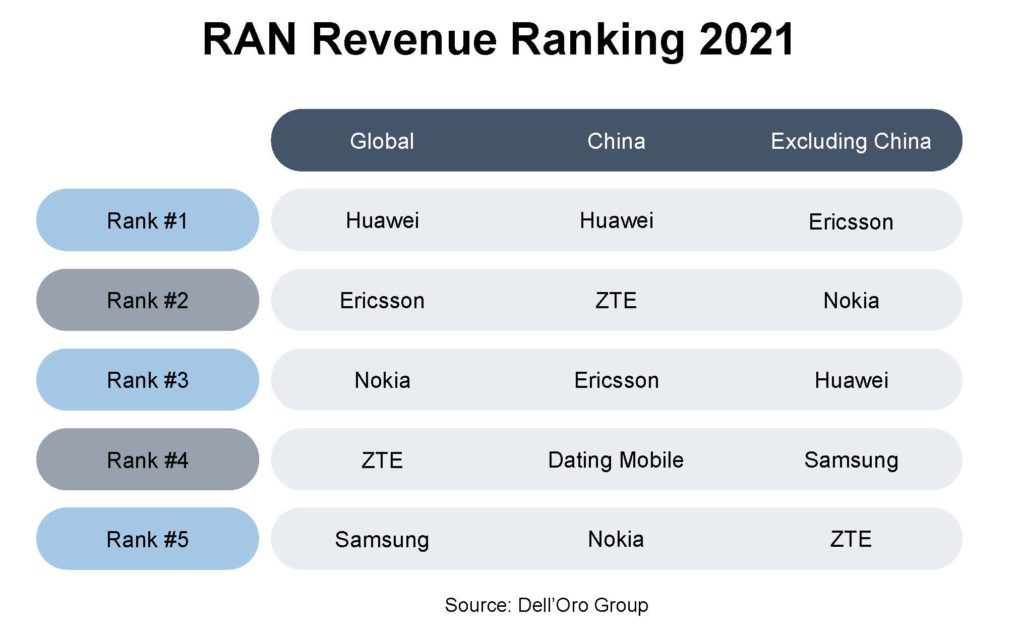RAN growth slowed in 4Q-2021, but full year revenues rose to ~$40B – $45B; Open RAN market highlights
Dell’Oro Group’s preliminary findings suggest Radio Access Network (RAN) growth slowed somewhat in the fourth quarter, though this was not enough to change the full-year picture. Total 2G-5G RAN revenues, excluding services, increased at a double-digit rate for a second consecutive year, propelling worldwide RAN to approach $40B to $45B.
“The RAN market continues to show remarkable resilience to a confluence of external factors,” said Stefan Pongratz, Vice President at Dell’Oro Group. “Even with the slower growth in the fourth quarter due partly to more challenging comparison, RAN prospects remain and healthy and the overall RAN market is on track to record a fifth consecutive year of growth in 2022,” continued Pongratz.
Additional highlights from the 4Q 2021 RAN report:
- Global RAN rankings did not change with Huawei, Ericsson, Nokia, ZTE, and Samsung leading the full year 2021 market.
- Ericsson, Nokia, Huawei, and Samsung lead outside of China while Huawei and ZTE continue to dominate the Chinese RAN market.
- RAN revenue shares are changing with Ericsson and Samsung gaining share outside of China.
- Huawei and Nokia’s RAN revenue shares declined outside of China.
- Relative near-term projections have been revised upward – total RAN revenues are now projected to grow 5 percent in 2022.
Dell’Oro Group’s RAN Quarterly Report offers a complete overview of the RAN industry, with tables covering manufacturers’ and market revenue for multiple RAN segments including 5G NR Sub-6 GHz, 5G NR mmWave, LTE, macro base stations and radios, small cells, Massive MIMO, Open RAN, and vRAN. The report also tracks the RAN market by region and includes a four-quarter outlook. To purchase this report, please contact us by email at [email protected].
…………………………………………………………………………………………………………………………
Open RAN Market Forecasts to 2030, by Research & Markets:
In December 2021, the UK Department of Culture, Media and Sport (DCMS) announced that it has agreed with the four domestic operators to fulfil a goal to boost Open RAN deployments setting a target of 35% of the nation’s mobile network traffic to be carried over Open RAN by 2030.The department also increased funding of £30 million to a total of up to £51 million to back projects for trials of open RAN and next-generation technology.
The Open RAN Market is expected to hit $32 Billion in revenues by 2030 with a growth rate of 42% for a forecast period between 2022 and 2030. Services are going to be the key contributor to this market with a 40% share in 2030, according to Research & Markets.
Open RAN Market – Highlights
- While 5G offers superior performance over 4G, both will coexist comfortably into the 2030s as the bedrock of next-generation mobile networks. There are three perspectives that help to underline this point. Firstly, unlike voice-oriented 2G and 3G (which were primarily circuit-switched networks with varying attempts to accommodate packet-switching principles), 4G is a fully packet-switched network optimized for data services. 5G builds on this packet switching capability. Therefore, 4G and 5G networks can coexist for a long while because the transition from 4G to 5G does not imply or require a paradigm shift in the philosophy of the underlying technology. 5G is expected to dominate the OPEN RAN market with $22B TAM in 2030 with a growth rate of 52% as compared to a 4G growth rate of 31% between 2022 and 2030
- Within OPEN RAN radio unit (RU), Small cells and macrocells are likely to contribute $7.5B and $2.4B TAM by 2030 respectively. It is going to be a huge growth of 46% from the current market size of $327M for such cells in the OPEN RAN market
- The sub-6GHz frequency band is going to lead the market with a 70% share for OPEN RAN although the mmWave frequency band will have a higher CAGR of 67% as compared to 37% CAGR of Sub-6GHz. Most focus has been on the 3.5 GHz range (i.e., 3.3-3.8 GHz) to support initial 5G launches, followed by mmWave awards in the 26 GHz and 28 GHz bands. In the longer term, about 6GHz of total bandwidth is expected for each country across two to three different bands
- Enterprises are adopting network technologies such as private 5G networks and small cells at a rapid rate to meet business-critical requirements. That’s why public OPEN RAN is expected to have the majority share of round ~95% as compared to the small market for the private segment
- At present, it is relatively easy for greenfield service providers to adopt 5G open RAN interfaces and architectures and it is extremely difficult for brownfield operators who have already widely deployed 4G. One of the main challenges for brownfield operators is the lack of interoperability available when using legacy RAN interfaces with an open RAN solution. Still, Mobile network operators (MNOs) throughout the world, including many brownfield networks, are now trialling and deploying Open RAN and this trend is expected to grow with time to have a larger share of brownfield deployments
- Asia Pacific is expected to dominate the OPEN RAN market with nearly 35% share in 2030. OPEN RAN market in the Asia Pacific is expected to reach USD 11.5 billion by 2030, growing at a CAGR of 34% between 2022 and 2030. Japan is going to drive this market in the Asia Pacific although China will emerge as a leader in this region by 2030. North America and Europe are expected to have a higher growth rate of more than 45% although their share will be around 31% and 26% respectively in 2030
References:



